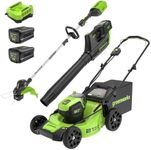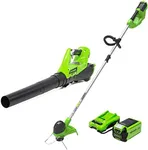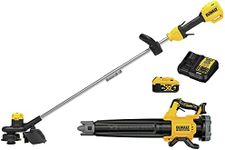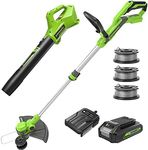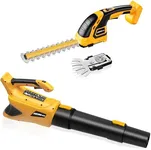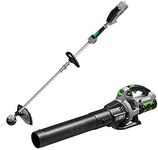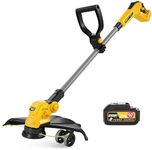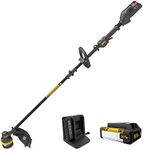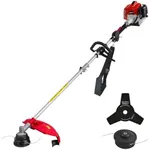Buying Guide for the Best Cordless Trimmer Blower Combo
Choosing the right cordless trimmer blower combo can make your yard work much easier and more efficient. These tools are designed to help you maintain your lawn and garden with ease, offering the convenience of cordless operation. When selecting a combo, it's important to consider several key specifications to ensure you get the best fit for your needs. Understanding these specs will help you make an informed decision and find a product that meets your specific requirements.Battery VoltageBattery voltage indicates the power output of the cordless trimmer and blower. Higher voltage batteries (e.g., 40V or 60V) provide more power and are suitable for larger yards or tougher tasks, while lower voltage batteries (e.g., 18V or 20V) are lighter and sufficient for smaller yards or lighter tasks. Choose a higher voltage if you have a large area to cover or need to tackle thick grass and heavy debris. For smaller, less demanding tasks, a lower voltage will be more than adequate and easier to handle.
Battery Capacity (Ah)Battery capacity, measured in ampere-hours (Ah), determines how long the battery will last on a single charge. Higher capacity batteries (e.g., 4Ah or 5Ah) will run longer, allowing you to complete more work without needing to recharge. Lower capacity batteries (e.g., 2Ah) are lighter but will need to be recharged more frequently. If you have a large yard or plan to use the tools for extended periods, opt for a higher capacity battery. For smaller yards or shorter tasks, a lower capacity battery will suffice and be less cumbersome.
WeightThe weight of the trimmer and blower is an important factor, especially if you will be using them for extended periods. Heavier models can be more tiring to use, while lighter models are easier to handle and maneuver. If you have a large area to cover or anticipate long usage sessions, look for lighter models to reduce fatigue. For smaller areas or shorter tasks, weight may be less of a concern, and you can focus more on other features.
Cutting Width (Trimmer)The cutting width of the trimmer determines how much grass or weeds it can cut in a single pass. Wider cutting widths (e.g., 14 inches or more) allow you to cover more ground quickly, making them ideal for larger yards. Narrower cutting widths (e.g., 10 inches) are better suited for precision work and smaller areas. Choose a wider cutting width if you need to trim large areas efficiently. For detailed work or smaller spaces, a narrower cutting width will provide better control.
Air Speed (Blower)Air speed, measured in miles per hour (MPH), indicates how powerful the blower is at moving debris. Higher air speeds (e.g., 150 MPH or more) are effective for moving heavy or wet debris, while lower air speeds (e.g., 100 MPH) are sufficient for lighter tasks like clearing dry leaves. If you need to clear large areas or deal with heavy debris, opt for a blower with higher air speed. For lighter, routine tasks, a lower air speed will be adequate and may be easier to control.
Air Volume (Blower)Air volume, measured in cubic feet per minute (CFM), indicates how much air the blower can move. Higher air volumes (e.g., 400 CFM or more) are better for moving large piles of leaves and debris, while lower air volumes (e.g., 200 CFM) are suitable for smaller tasks. If you have a large yard with lots of debris, choose a blower with a higher air volume. For smaller areas or less frequent use, a lower air volume will be sufficient and more manageable.
RuntimeRuntime refers to how long the trimmer and blower can operate on a single battery charge. Longer runtimes are beneficial for larger yards or extended tasks, while shorter runtimes may be sufficient for smaller areas. If you have a large yard or plan to use the tools for long periods, look for models with longer runtimes. For smaller yards or shorter tasks, a shorter runtime will be adequate and may come with the benefit of a lighter battery.
Charging TimeCharging time is the amount of time it takes to fully recharge the battery. Faster charging times are convenient if you need to get back to work quickly, while longer charging times may require more planning. If you need to use the tools frequently or for long periods, look for models with shorter charging times. For occasional use or smaller tasks, longer charging times may be acceptable.


